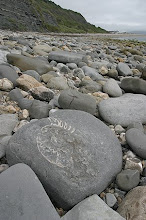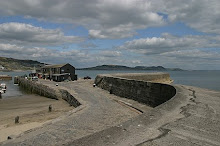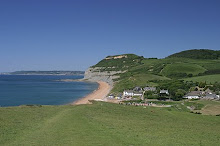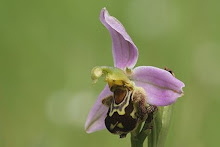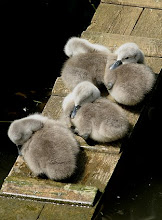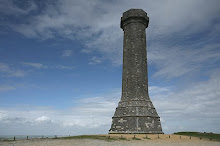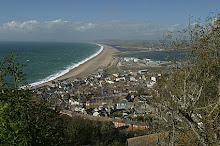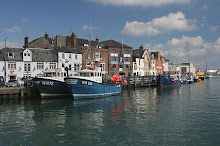From Exmouth in Devon to Swanage in Dorset the Jurassic Coast is a World Heritage Site and the Dorset share starts at Lyme Regis . We will go from the Cobb, started by Edward 1 and our first part of the journey will end at Seatown, in Dorset, not Seaton in Devon. Lyme is famous for its fossils and perhaps the foremost of the fossil collectors was Mary Anning who discovered an ichthyosaur in 1814 but Jane Austen and the Duke of Monmouth have also claims to fame in the town but not for fossil collecting! The beach where fossils can be found is called Monmouth Beach and it is also a good site for wild flowers, including the Horned Poppy. From the Cobb, built to provide protection for the harbour we can see the highest point on the south coast of England, known as Golden Cap, and this is at Seatown or just before it but there is parking at Seatown and then a walk will take you to the peak so head down the A35, to the village of Chideock. The traffic that collects here in high season is appalling but in the middle of the town you will be directed right and down a narrow lane to Seatown and a car park opposite the Anchor pub.
Travelling once more along the A35 we pass Bridport to the north of us and reach a roundabout at the back of West Bay and here we follow the road to Abbotsbury, the B3157, passing through Burton Bradstock and Swyre along the way. In Swyre there is a turning on the right that takes you down to the sea at a place called West Bexington, and here you can park and walk or fish and rest, what ever takes your fancy. I have spent some pleasant times walking around the Dorset Wildlife Trust reserve here trying to find migrant birds and orchids, sometimes with a little success.; this Water Rail was one success but as yet the Southern Marsh Orchids are proving elusive but as I have some closer to home I don’t mind too much!
My passion for orchids will became more apparent as we journey along the Dorset coast.
West Bexington is near the western end of Chesil Beach and here the pebbles that make the beach are at their smallest. The pebbles get larger towards the Portland end of this beach and the story goes that locals can tell where they are on the beach, in a fog, by the size of the pebbles; this beach is about 18 miles long!
Before we get to Portland we come to Abbotsbury and the Sub-tropical Gardens, the Swannery, St. Catherine’s Chapel and the Tithe Barn will be awaiting you in this beautiful part of Dorset. Approaching from the west the coast road shows Chesil beach to its full advantage and the Fleet, the lagoon at the back of the beach is clearly visible, as is St. Catherine’s Chapel, a building which is perhaps 700 years old and still used occasionally to this day as a place of worship but before we get here we have to visit the sub-tropical gardens, signposted at the bottom of the hill on the approach to the village, on a road leading once more down to Chesil Beach.
The gardens are a treat at any time of the year but, being a lover of Azaleas and Rhododendrons I do enjoy being here in the spring time. One of the rare treats in this area is the Bee Orchid and this one was growing at the entrance to the gardens car park with most people walking straight past it! This beautiful plant, perhaps between 8 and 10 inches tall, had 3 flowers on it and, as is quite often the case with Bee Orchids, they are not all open at once so this is the flower at the top of the stem.
The road past the gardens leads to the beach car park and to the east you can see Portland and the west Lyme Regis where we started our journey. The beach plays host to many plants, one of the more unusual being the Sea Pea, growing at the back of the great bank of shingle which affords it protection. This unusual plant can be seen in flower here, along with the Sea Campion, as late as the end of August but perhaps July is a better bet. Having found the Sea Pea it is now time to visit Saint Catherine’s Chapel, either by following the path at the back of the beach to the east or by driving into Abbotsbury and taking the footpath from the main street, to the west of the Ilchester Arms, which, by the way, is not a bad place for lunch.
The chapel is a landmark for mariners, standing high on the hill and plainly visible from the sea, almost a beacon before the days of GPS.
The Swannery is reached by turning right and one of the most dangerous corners in Dorset but don’t let that put you off as a visit here in late may or June is one of the delights of this area. The Swannery was established by Benedictine monks in the 11th Century and the swans farmed in those days helping to stock the tables of the monastery. The Swans gathered here to eat the Eel grass found on the bed of the Fleet and are still doing so today but their diet is now supplemented by the Swannery to the extent that there are now up to 600 Mute Swans here plus other wild fowl enjoying the hospitality; a place well worth visit especially at hatching time.
We are just taking a quick trip in land now, up to the Hardy Monument. This can be reached via the village of Portesham, and is dedicated to Thomas Hardy but not the author. Thomas Masterman Hardy, who was born in the village of Portesham, was Nelson’s flagship captain and it was in his arms that Nelson died at the Battle of Trafalgar in 1805, this monument was erected in his honour after his death in 1839. From this vantage point there is almost a full 360 degree view of the landscape and Portland, which is 13 ½ miles away is clearly visible. The car park is operated by a local farmer so please leave a donation in his collection box, and the monument itself is open at weekends from April to September should you wish to climb to the top!
And so from Portesham and the Hardy Monument we come back and join the B3157 and head for Portland and, if you haven’t had a bite to eat, then you could do worse than call in at the Elm Tree at Langton Herring, where there is a very pleasant garden in the warmer months.
Portland is, to all intents and purposes, an island, joined to the mainland by the end of Chesil Beach. the harbour used to be for the Royal Navy but now it is for the use of sailors of an Olympic kind although they are still protected by Portland Castle, one of Henry VIII’s many fortifications. As you reach the top of the hill at Fortuneswell you really have to stop and enjoy the view to the west, frankly there is nothing like it and stunning seems to trite a word. Portland has many large quarries, its stone being used in many of England’s finest buildings, among them Saint Paul’s Cathedral and Buckingham Palace but it is also an area of strong currents and shallow water and to this end three light houses have been built here over the years, the latest standing at the tip of the land, known as the Bill of Portland. There are many wild flowers growing on Portland in the old, disused quarries and the coastal strip and it is a magnificent spot to watch bird migration from. This is Thrift, a common enough plant in Dorset but nonetheless pretty for that.
From Portland we go on to Weymouth, one of Dorset’s most popular holiday destinations with sandy beaches and many visitor attractions, one of the most famous patrons of this resort being George 111, who enjoyed the bathing here. The roots of the town can be traced back to Roman times when it was used as a port after the invasion and capture of Maiden Castle, near Dorchester. The town has an inner and outer harbour and 2 RSPB reserves, Lodmoor and Radipole, and is a good centre for touring other parts of Dorset. One last observation: the area was made famous on the 25th June 1348 for importing the Black Death which went on to wipe out large areas of the population of England!
From Weymouth we take the A353 and head for our next port of call which will be Durdle Door and Lulworth but we have to go past a no through road that leads to Osmington Mills, where there are good views of the coast and a pub called the Smugglers Inn, where the food is good and the staff very friendly, another good place for lunch but, be warned, parking is limited so get there early!
skip to main |
skip to sidebar

A snapshot of Dorset with the Tom Tom GO 530
Don't get your feet wet!
The highest point on the south coast of England. the Anchor pub is in the middle of the picture
Followers
Blog Archive
About Me

- Sam Turtle
- I was a photographer for some years and now thankfully it is part time! Now I have a web site:- www.samturtlephotography.com.
